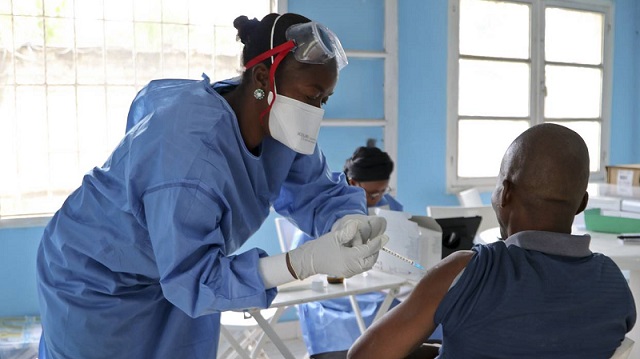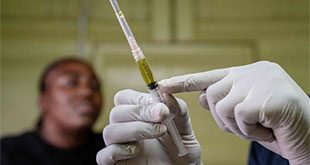
Kampala, Uganda | THE INDEPENDENT | The Ebola Treatment Unit-ETU at Naguru General Hospital is under equipped, URN has learnt. According to doctors, the unit lacks equipment and facilities needed to offer quality care to Ebola patients. Apparently, if an Ebola case was rushed to the Ebola Treatment Unit at Naguru General Hospital, health workers would find it hard to measure the blood pressure of patients, carry out continuous tests and provide them oxygen in case they can’t breathe on their own.
Our reporter visited the unit on Friday last week and found it deserted. There was no activity in the facility, which is fenced with chain link. The doors were under lock and key. The unit comprises of three wards. Each ward is a standalone building measuring approximately 10 meters squared.
At the triage or reception ward, an empty white 10 liter jerrycan that is supposed to contain 0.5 chlorine solution for hand washing sits on a metallic stand in a corner of the small room gathering dust.
A one liter bottle of Saraya alcohol based hand sanitizer also mounted on a wall gathers dust. Dr. Mukanga Kizito, the head of the Naguru Hospital Isolation Unit and Ebola Treatment, says they are supposed to be on standby mode, ready to handle any Ebola case that makes its way to Kampala. “But as we stand now, we lack a lot of equipment to say that we are ready 100 percent,” he said. Dr. Kizito says the first challenges they face is the space in the ETU. He explains that the ETU was initially built to offer care for health workers affected by Ebola. He says the ETU is small and wouldn’t be able to handle a big Ebola outbreak.
Dr. Kizito says due to the limited space, so many World Health Organisation-WHO recommendations are not being adhered to, saying they are forced to work with what they have. “The space that we do not have is not enough. Ideally a bed is supposed to be two meters off the bed and two meters away from the next bed. Ideally each ward at their current size is supposed to have only two beds instead of the four there. As it is a health worker would not be comfortable,” Dr. Kizito. Dr. Kizito says the facility lacks key monitoring and investigative equipment at the ETU.
Dr. Kizito explains that even if Naguru hospital has a laboratory, using the current laboratory could spread the disease to other parts of the country.
The treatment unit also lacks an oxygen supply system, which according to Dr. Kizito is very important because many patient Ebola patients need oxygen. He says they need a minimum of one oxygen concentrator per ward.
According to the Health Ministry, more than Shillings 100 million was used to construct the structures housing the unit. The Naguru ETU is not the only one that is poorly furnished. Other districts categorized as high risk because they share a border with the DRC are facing similar problems. Health officials from some of the districts told URN that something needs to be done to avail them with necessary equipment and skills, saying as it stands the lives of health workers are at risk.
According to health officials, the level of preparedness is still low. Most category three districts do not have personal protective gears or solutions. In other cases, some districts even lack designated isolation units, which puts many health workers and people in the community at risk.
Dr. Seth Tibenda, the Rubirizi District Health Officer, says the district doesn’t even have an Ebola Treatment Unit-ETU. He says health workers are always at risk or acquiring the disease.
Dr. Agatha Kebirungi, the Infection Control and Prevention Focal Person at Nyakibaale hospital in Rukungiri, says that they only have 30 percent of the required equipment in terms of Ebola treatment.
According to the health ministry second Ebola preparedness plan that is currently being implemented, Shillings 64 billion was budgeted for the country’s Ebola response. Preparedness was divided into three categories. In category one, Kasese were three cases were confirmed was allocated Shillings 18 million.
Shillings 25 million was allocated to category two-districts that share borders with DRC in parts where Ebola cases have been reported and Shillings 14 million for districts that share borders with DRC but are near areas that have not yet been affected by the disease.
Health Ministry officials say that government is doing everything possible to address the gaps. Dr. Harriet Kembabazi, the Principal Nursing Officer Clinical Nursing Services, says there are many challenges faced by health facilities when it comes to infection control.
Dr. Olaro Charles, the Director of Clinical Services, says the Health Ministry is working towards providing all health facilities with equipment. “Right now, we have availed equipment to some facilities and are working towards making sure all districts are given the equipment that they need,” he said.
As of September 22, 2019, 3168 EVD cases were reported, including 3057 confirmed and 111probable cases, of which 2118 cases died (overall case fatality ratio 67%). Of the total confirmed and probable cases with reported sex and age data, 56% (1772) were female, 28% (900) were children aged less than 18years, and 5% (160) were healthcare workers.
Despite the lack of major equipment, Dr. Kizito says that his team is ready to deal with any outbreak. “As doctors, we are first called to serve and with the little we have are making sure that we can offer assistance when the time comes. We carry out internal simulation exercises to make sure that everyone knows what to do and how to protect themselves.”
*****
URN
 The Independent Uganda: You get the Truth we Pay the Price
The Independent Uganda: You get the Truth we Pay the Price





